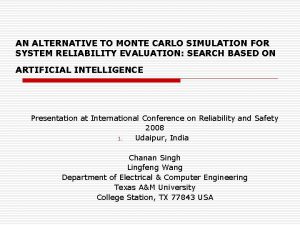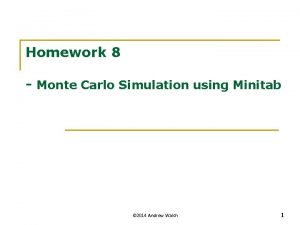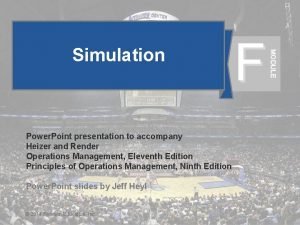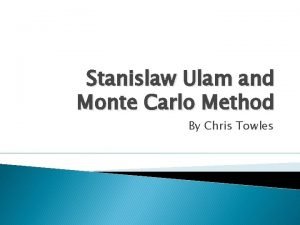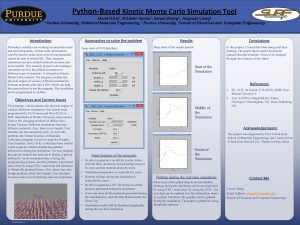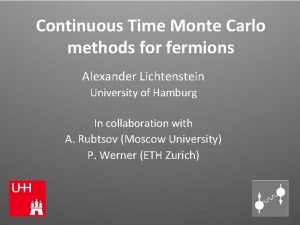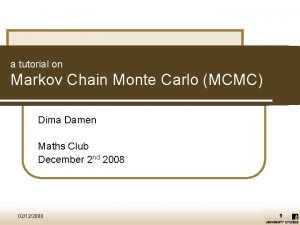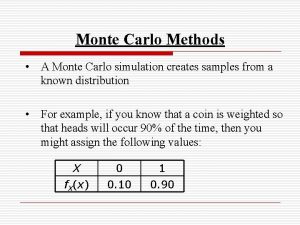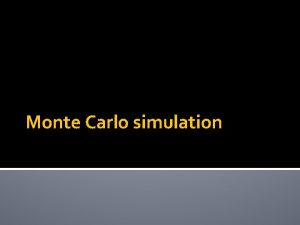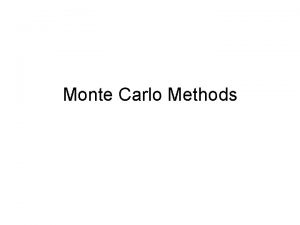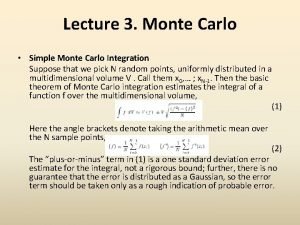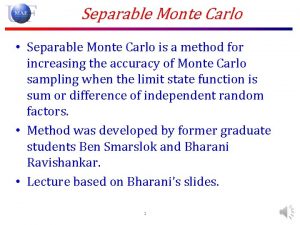AN ALTERNATIVE TO MONTE CARLO SIMULATION FOR SYSTEM






















- Slides: 22

AN ALTERNATIVE TO MONTE CARLO SIMULATION FOR SYSTEM RELIABILITY EVALUATION: SEARCH BASED ON ARTIFICIAL INTELLIGENCE Presentation at International Conference on Reliability and Safety 2008 1. Udaipur, India Chanan Singh Lingfeng Wang Department of Electrical & Computer Engineering Texas A&M University College Station, TX 77843 USA

Objective o o The basic objective of reliability analysis is to compute some measure/index of the systems inability to do its intended function, taking into account uncertainties. Commonly used measures or indices are : n n Pf: Probability of failure Frequency and mean duration of failure

Basic Steps of Reliability Assessment

Reliability Evaluation Methods o o o Dimensionality of state space is a major issue: A system consisting of n, m-state components will has mn states Methods of system reliability analysis have been traditionally considered to fall into two broad categories: analytical and simulation methods (Monte Carlo Simulation). The analytical techniques use some device to circumvent the problem of straightforward enumeration such as state merging, truncation, and implicit enumeration. The simulation methods select system states based on their respective sampling mechanisms. More recently, artificial intelligent based algorithms such as intelligent search and neural networks have shown promise - in state selection as an alternative to Monte Carlo Simulation - in state evaluation as an aid to Monte Carlo Simulation - other possibilities

Classification of System States

Reliability Evaluation Steps o o o Sampling/selection of states: The states may be selected using an analytical approach, random and sequential sampling in MCS, or intelligent (fitness-guided) search in IS. The sampled state is defined by the status of all components comprising the system. Evaluation of states: This step is to determine whether the intended function can be performed with the given status of components. Estimation of indices: Reliability indices are estimated from the repeated use of the two previous steps.

State Evaluation o o o Any selected state first needs to be evaluated before it can be classified as a failed or success state. The state evaluation may be simple in some situations. The state evaluation in some applications like networks can be computationally intensive and may constitute the most significant part of computational burden.

Two Observations o o The number of states sampled or selected for evaluation should have as higher percentage of failed states as possible within the computational framework of the method. The technique for state evaluation should be efficient.

Monte Carlo Simulation for LOLP (Loss of Load Probability) Calculation o o o LOLP is Pf for power systems Step 1: Select the seed for the random number generator. Set the maximum iteration number and let the initial iteration number k = 1; Step 2: Sample the system state randomly (load level, generation status and line status) and perform a flow calculation to classify it as loss-of-load or otherwise. o Step 3: Calculate LOLP, variance of the estimated LOLP and the coefficient of variation. o Step 4: Check whether the coefficient of variation is less than a specified threshold. If yes, stop; otherwise, k=k+1, go to step 2.

Random Sampling In MCS o o o In MCS both the success and failed states enter the index calculation. One can not focus on the identification of the failed states alone but a proportional number of success states need also be generated to calculate the reliability index. One should keep in mind though that both success and failure states will need to be evaluated before they can be classified as such.

Two Aspects o o Directed intelligent search as an alternative to proportionate sampling in MCS Making state evaluation faster in MCS

Population-based Intelligent Search (PIS) as Alternative to MCS o o o Step 1: A population of individuals is randomly created. Step 2: Each individual is evaluated based on the specified objective function, which is used to measure the “fitness” of each individual. Step 3: Determine if any stopping criterion is satisfied. If yes, halt the PIS algorithm; otherwise, go to next step. Step 4: Different PIS operations, depending on the method, are applied to each individual in order to create the next generation of individuals. Return to Step 2 until any stopping criterion is satisfied.

State Selection In PIS o o In PIS, only the failure states contribute to the index calculation. The focus here is to generate the dominant failure states and minimize generation of success states. Success states also will be created during this process but the efficiency depends on the design of the fitness function to minimize the generation of success states. In this fashion, much fewer states need to be evaluated than the MCS.

State Selection In PIS (Cont’d) o o o PIS-based algorithms can have a special advantage in cases where considerable time is needed to evaluate a sampled state. Since in MCS, majority of the states sampled are success states, this state evaluation will need be carried out more often. On the other hand, in PIS the states are sampled in a more directed fashion and thus the evaluation process will be used more efficiently.

Fitness Function-GA Example o The suitable choice for the evaluation function can add the required intelligence to GA state sampling

Key Idea: GA for State Sampling System State Space X X X X Initial random states X X X X XX X X Failure state with highest probability Guided GA search through a fitness function üGuided intelligent search üInformation about system failure scenarios üLess computational effort

Case Study One: PIS-based State Selection o o o A WTGs-augmented IEEE RTS-79 is used. The original RTS has 24 buses (10 generation buses and 17 load buses), 38 lines and 32 conventional generating-units. The system annual peak load is 2850 MW. The total installed generating capacity is 3405 MW. In this study, one unconventional subsystem comprising of multiple identical WTGs is added to the RTS. Each WTG has an installed capacity of 1 MW, a mean up time of 190 hours and a mean down time of 10 hours. The hourly derating factors for WTG output are specified. Reliability indices are calculated for a time span of one week and the load cycle for week 51 with peak load 2850 MW, low load 1368 MW and weekly energy demand 359. 3 GWh. The impact of wind power penetration is examined by incorporating installed wind power capacity of 400 MW.

Methods used o o o ACS: Ant Colony System AIS: Artificial immune system BPSO: Binary particle swarm optimization GA: Genetic algorithms MCS: Monte Carlo Simulation

Reliability Indices for Unconventional Capacity 400 MW LOLE: h/week; EENS: MWh; LOLF: occ. /week; Time: seconds.

Some Comments o o The convergence time in MCS is inversely proportional to the loss of load probability of the system but PIS methods are much less effected by the loss of load probability. The estimate of index in MCS could be lower or higher than the true value but is always lower in PIS methods.

EENS(MWh) An Example: GA vs. Monte Carlo Random Sampling Computational Time in SEC

Concluding Remarks o o o Artificial intelligence techniques have drawn much attention in dealing with complex and challenging problems in power systems. Most of these applications are for optimization and pattern recognition. Our focus on their application as a search technique as an alternative to MCS shows promise. In this study, some concepts on reliability evaluation based on population-based intelligent search as well as neural network enhanced MCS are presented. It appears that the intelligence based methods hold promise for reliability studies both as an alternative to MCS and as an aid.
 Monte carlo alternatives
Monte carlo alternatives Monte carlo simulation minitab 19
Monte carlo simulation minitab 19 Monte carlo simulation advantages and disadvantages ppt
Monte carlo simulation advantages and disadvantages ppt Monte carlo method matlab
Monte carlo method matlab Monte carlo simulation freeware
Monte carlo simulation freeware Concezio bozzi
Concezio bozzi Monte carlo simulation
Monte carlo simulation Monte carlo simulation
Monte carlo simulation Monte carlo simulation dice roll matlab
Monte carlo simulation dice roll matlab Minitab monte carlo simulation
Minitab monte carlo simulation Count of monte carlo
Count of monte carlo Stanislaw ulam monte carlo
Stanislaw ulam monte carlo Simulasi monte carlo
Simulasi monte carlo Monte carlo vs temporal difference
Monte carlo vs temporal difference Kinetic monte carlo python
Kinetic monte carlo python Connect 4 monte carlo tree search
Connect 4 monte carlo tree search Monte carlo path tracing
Monte carlo path tracing Monte carlo localization for mobile robots
Monte carlo localization for mobile robots Continuous time monte carlo
Continuous time monte carlo Markov chain monte carlo tutorial
Markov chain monte carlo tutorial Monte carlo localization python
Monte carlo localization python Monte carlo radiation transport
Monte carlo radiation transport Metoda monte carlo algorytm
Metoda monte carlo algorytm
